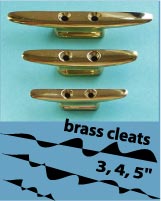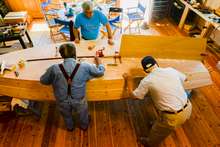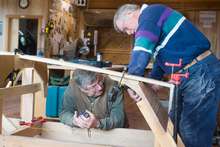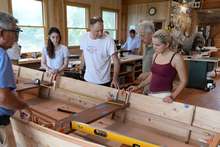
 Custom Search
|
| boat plans |
| canoe/kayak |
| electrical |
| epoxy/supplies |
| fasteners |
| gear |
| gift certificates |
| hardware |
| hatches/deckplates |
| media |
| paint/varnish |
| rope/line |
| rowing/sculling |
| sailmaking |
| sails |
| tools |
| join |
| home |
| indexes |
| classifieds |
| calendar |
| archives |
| about |
| links |
| Join Duckworks Get free newsletter CLICK HERE |
|
|
| August Reports |
Chevy Duck
Chevy Duck based on my OzRacer RV plan. Photo by Josh of Small Craft Advisor Magazine. Part of the 8ft duck contingent moving right along. MIK Storer Oz PD GooseVery fun sail today. I took a beating, but it was worth it. This is not the sailing I imagined while we were building the Goose. Interesting how things work out differently. Here are a few minutes from tearing around today. The airport recorded 18-30 kts while I was out. Gusty and variable was the rule. I was in more protected water this time, so didn't have to deal with the bone-rattling short chop. Top speed was 10.3 kts according to the Garmin. Hit 10 kts four or five times. I don't know if this video has the fastest parts, but it paints a good picture of how the day went. Had my first unintentional swim today, but the battery in the camera was dead by then. Nothing dramatic, just got a line snagged on a tack and went over. Easy recovery. Thanks MIK, we're having fun in your boat. Ian Henehan Duck Plaque
My dad loves his Duck Plaque! Thank you to everyone who sailed a Duck and carried his duck with them. Michelle Monies Evening sail on the Anastasia RileyFinally got some wind without lightning bolts in Florida. First video of our Goose too! Madison went with me for a father/daughter sail. She was a great first mate! Tony Goat Island Skiff
Here is a completed goat except for the paint and varnish. It is hanging by it's ear because it is easier to work on horizontal surfaces. I'm down to the finish sanding and paint/varnish. I hope to have water tickling the keel/centerboard soon. Jerry Documentary
Wa Kuk Wa Jimor - Marshallese Canoes Today from Rachel Miller on Vimeo Documentary on the remarkable Marshallese sailing canoes. MIK Storer LiveStrong
That's a nice story - great job, guys! PS: There's still time to contribute to the LiveStrong Foundation Andrew Linn Just Another day at the Office...Chuck CRBB Day
CRBB Day at the Crystal River Preserve State Park day camp. The kids toured the SPIRIT, learned about the tools we used to build her, and then put together and sailed their own model of the scow! Bill Self ExplanatoryChuck GIS
Christophe's former Goat Island Skiff is featured in Ash Breeze magazine. MIK Storer BlogInteresting blog by some guys who have great ideas, and crazy luck , good thing because the lack of planning can kill! Blogging Story"Sailing into hell: two men, a dinghy and one of the luckiest escapes ever." A boggling story. See youtube clip in comments. MIK Storer GIS
Aleksander Bajt from Slovenia emailed me some pics of his magnificent Goat Island Skiff which I'm sharing. I'm sure you'll agree Miss Retro is a stunner. From Storer Boat Plans facebook group. MIK Storer Summer Breeze
I finally got around to taking a few pictures. As you can see I wasn't good about taking them as the build progressed, but at least I did take some. PDR
New Blue boat in the backyard. Ted from Facebook Classic Boat Fair To Showcase And Sell Vintage Wooden BoatsVintage wooden sailboats and rowing boats, some decades old, will on display and for sale Saturday July 19 at the Amagansett headquarters of the East End Classic Boat Society. The annual Classic Boat Fair from 10 a. m. to 4 p. m. takes place on the grounds of and inside the Society's Community Boat Shop at 301 Bluff Road where volunteers build reproductions and restore classic watercraft. Among the boats that are up for sale include one by classic designer Joel White, a 15-foot shearwater double-ended rowboat with a lug rig for sailing, a 15-foot Six-Hour canoe, a 12-foot Bevins skiff, a Bahama dinghy and a 16-foot Old Town canoe. Besides the boats on view outdoors, visitors can come inside to the Society's workshop next to the Maritime Museum to view the equipment and look at the extensive restoration underway on a 1921 Herreshoff 12 ½ sloop, a boat first designed in 1914.
Photos by Hugh Patrick Brown The project includes replacing the transom and stem, putting in new ribs and refinishing floor boards, seats and spars. Members are also at work constructing a 14-foot East End Sharpie. The sharpie a flat bottomed boat designed for rowing and sailing first built at the end of the 19th century. It was used for fishing and oystering work. "It's a traditional waterman's workboat for working in shoal waters off the East End and the Chesapeake," explained Ray Hartjen, the society's president. Hartjen said the club, which meets from 9 a. m. to 2 p. m. every Wednesday and Saturday of the year and is open to anyone of any skill level and is "all about mastering the skills of traditional boat building." The Sharpie, when completed will be the prize of the society's annual raffle drawing, which raises funds to pay the non-profit group's costs. Tickets will be available at the fair. Upside Down
Fastening rub rails can be a pita. Joe from Facebook Pirate ShipHere are a couple of pics of our pirate ship. From the tip of the bowsprit to the stern is 31'. The tanbark sails that Duckworks made are beautiful, and I'll send another pic with them up. Rob Farrell Why Boats Sink
10 Prevention Tips from BoatUS ALEXANDRIA, Va., June 30, 2014 -- When a boat sinks, that’s likely the end of her. That’s because repairs on a sunken boat often cost more than the actual value of the boat. So if boaters want to prevent a sinking at all costs, what can they do? Boat Owners Association of The United States (BoatUS) recently took its first significant look since 2006 at its boat insurance claims files to identify the causes of boat sinkings and found that most were preventable. About two out of every three (69%) boats sink at the dock or mooring, while the remainder (31%) sink while underway. Of all of the dock/mooring sinkings, 39% occur when some small part gives up the fight with water due to wear, tear and corrosion. When it comes to gradual leaks due to slowly failing parts, too many boats existed in a “zombie state” somewhere between floating and sinking, dependent upon the bilge pump, which merely postponed the sinking until the pump failed or was overwhelmed. This one is a no-brainer: lack of maintenance is the factor here. For boat sinkings while underway, the most common cause (43%) is hitting something – a log, the bottom or colliding with another boat or dock. Some of these sinkings might have been avoided if some some extra care had been taken – and some can be chalked up to simply bad luck. Interestingly, low-cut transoms that were common on boats in the 1990’s and a cause of sinkings is no longer much of a factor, as contained splash wells separating the interior of the boat from the transom are more common in boat designs today. However, being swamped while tied stern-to waves remains a cause. To prevent a sinking, here are ten tips from the boat owner’s group:
|
To comment on Duckworks articles, please visit one of the following:
|
 |



















